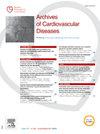Targeting Ly6G increases fibrosis after MI by inducing neutrophil phenotype switch and modulating their communication with post MI heart cells
IF 2.2
3区 医学
Q2 CARDIAC & CARDIOVASCULAR SYSTEMS
引用次数: 0
Abstract
Introduction
Myocardial infarction (MI) generates a complex immune response involved in tissue repair and remodeling. Neutrophils infiltrating the heart present a heterogeneous profile, appear dynamically in the tissue and show multifaceted beneficial and deleterious roles after MI. However, studies assessing the role of neutrophils after MI rely on partially efficient depletion strategy targeting Ly6G in mice, rendering them possibly biased.
Objective
We aimed to decipher the role of neutrophil subsets in cardiac repair and in shaping cardiac immune cell phenotypes in the heart after MI.
Method
We used a mouse model of experimental MI induced by permanent coronary artery ligation, and depleted neutrophils using a combination of antibodies (Rat IgG2aκ anti-Ly6G + anti-rat IgG2aκ). Five days after MI, we analyzed cardiac CD45+ cells by scRNA-seq in combination with CITE-seq for surface marker analysis. Fourteen days after MI, we evaluated survival rate and cardiac remodeling by histology.
Results
Despite 70% decrease in neutrophil number after depletion in the heart 3 days after MI, a specific neutrophil population appears in response to α-Ly6G antibody, that arbors a unique transcriptomic signature 5 days after MI. We show that targeting Ly6G increases cardiac fibrosis and affects immune cell infiltration composition in the heart. Depletion of neutrophils strongly increases γδ T cells, monocytes and interferon response-associated macrophages accumulation in the heart. Pseudo-bulk analysis reveal differential gene expression in these populations after neutrophil depletion, indicating neutrophil ability to modulate immune cells recruitment and phenotype. We further show that neutrophils and γδ T cells can communicate directly with fibroblasts: α-Ly6G-induced neutrophil population is more likely to drive fibrosis and γδ T cells lead to increase proliferation and inflammatory activation of fibroblasts in vitro.
Conclusion
Overall, our data indicate that neutrophils shape local cardiac immune responses after MI and suggest a multifaceted role of neutrophils subpopulations. Results observed after α-Ly6G based depletion might rather be due to specific neutrophil population recruitment than absence of neutrophils. γδ T cells recruitment is highly affected by α-Ly6G antibody treatment and can participate to increased fibrosis.
靶向Ly6G通过诱导中性粒细胞表型开关和调节其与心肌梗死后心脏细胞的通讯,增加心肌梗死后的纤维化
心肌梗死(MI)产生复杂的免疫反应,参与组织修复和重塑。浸润心脏的中性粒细胞呈现异质性,动态地出现在组织中,并在心肌梗死后显示出多方面的有益和有害作用。然而,评估中性粒细胞在心肌梗死后作用的研究依赖于部分有效的针对小鼠Ly6G的消耗策略,因此可能存在偏见。目的探讨中性粒细胞亚群在心肌梗死后心脏修复和心脏免疫细胞表型形成中的作用。方法采用永久性冠状动脉结扎诱导的实验性心肌梗死小鼠模型,并使用联合抗体(大鼠igg2akk抗ly6g +抗大鼠igg2akk)来消耗中性粒细胞。心肌梗死后5天,我们用scRNA-seq结合CITE-seq对心脏CD45+细胞进行表面标记分析。心肌梗死后第14天,我们通过组织学方法评估生存率和心脏重构情况。结果心肌梗死后3天,心脏中性粒细胞数量减少70%,α-Ly6G抗体在心肌梗死后5天出现特异性中性粒细胞群体,该抗体具有独特的转录组特征。我们发现靶向Ly6G会增加心脏纤维化并影响心脏免疫细胞浸润组成。中性粒细胞的消耗强烈增加了γδ T细胞、单核细胞和干扰素反应相关的巨噬细胞在心脏中的积累。伪散装分析揭示了中性粒细胞耗竭后这些群体中基因表达的差异,表明中性粒细胞调节免疫细胞募集和表型的能力。我们进一步表明,中性粒细胞和γδ T细胞可以直接与成纤维细胞交流:α- ly6g诱导的中性粒细胞群体更有可能驱动纤维化,γδ T细胞导致体外成纤维细胞的增殖和炎症激活增加。总的来说,我们的数据表明,中性粒细胞塑造心肌梗死后局部心脏免疫反应,并提示中性粒细胞亚群的多方面作用。α-Ly6G耗竭后观察到的结果可能是由于中性粒细胞群体的特异性募集,而不是中性粒细胞的缺失。γδ T细胞募集受到α-Ly6G抗体治疗的高度影响,并可参与纤维化的增加。
本文章由计算机程序翻译,如有差异,请以英文原文为准。
求助全文
约1分钟内获得全文
求助全文
来源期刊

Archives of Cardiovascular Diseases
医学-心血管系统
CiteScore
4.40
自引率
6.70%
发文量
87
审稿时长
34 days
期刊介绍:
The Journal publishes original peer-reviewed clinical and research articles, epidemiological studies, new methodological clinical approaches, review articles and editorials. Topics covered include coronary artery and valve diseases, interventional and pediatric cardiology, cardiovascular surgery, cardiomyopathy and heart failure, arrhythmias and stimulation, cardiovascular imaging, vascular medicine and hypertension, epidemiology and risk factors, and large multicenter studies. Archives of Cardiovascular Diseases also publishes abstracts of papers presented at the annual sessions of the Journées Européennes de la Société Française de Cardiologie and the guidelines edited by the French Society of Cardiology.
 求助内容:
求助内容: 应助结果提醒方式:
应助结果提醒方式:


